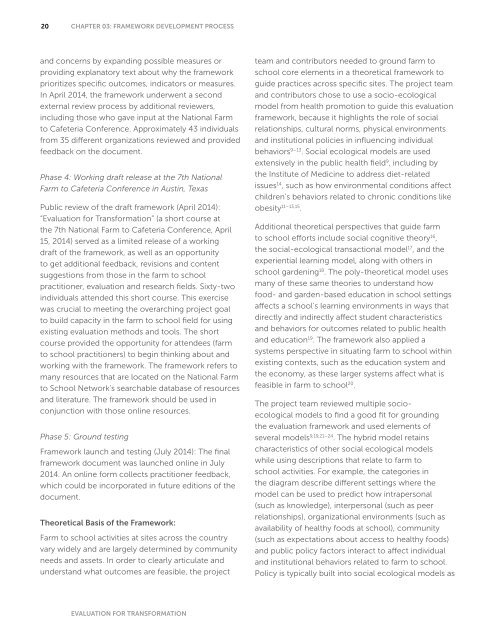Framework-08-25-14_web
Framework-08-25-14_web
Framework-08-25-14_web
You also want an ePaper? Increase the reach of your titles
YUMPU automatically turns print PDFs into web optimized ePapers that Google loves.
20 CHAPTER 03: FRAMEWORK DEVELOPMENT PROCESSand concerns by expanding possible measures orproviding explanatory text about why the frameworkprioritizes specific outcomes, indicators or measures.In April 20<strong>14</strong>, the framework underwent a secondexternal review process by additional reviewers,including those who gave input at the National Farmto Cafeteria Conference. Approximately 43 individualsfrom 35 different organizations reviewed and providedfeedback on the document.Phase 4: Working draft release at the 7th NationalFarm to Cafeteria Conference in Austin, TexasPublic review of the draft framework (April 20<strong>14</strong>):“Evaluation for Transformation” (a short course atthe 7th National Farm to Cafeteria Conference, April15, 20<strong>14</strong>) served as a limited release of a workingdraft of the framework, as well as an opportunityto get additional feedback, revisions and contentsuggestions from those in the farm to schoolpractitioner, evaluation and research fields. Sixty-twoindividuals attended this short course. This exercisewas crucial to meeting the overarching project goalto build capacity in the farm to school field for usingexisting evaluation methods and tools. The shortcourse provided the opportunity for attendees (farmto school practitioners) to begin thinking about andworking with the framework. The framework refers tomany resources that are located on the National Farmto School Network’s searchable database of resourcesand literature. The framework should be used inconjunction with those online resources.Phase 5: Ground testing<strong>Framework</strong> launch and testing (July 20<strong>14</strong>): The finalframework document was launched online in July20<strong>14</strong>. An online form collects practitioner feedback,which could be incorporated in future editions of thedocument.Theoretical Basis of the <strong>Framework</strong>:Farm to school activities at sites across the countryvary widely and are largely determined by communityneeds and assets. In order to clearly articulate andunderstand what outcomes are feasible, the projectteam and contributors needed to ground farm toschool core elements in a theoretical framework toguide practices across specific sites. The project teamand contributors chose to use a socio-ecologicalmodel from health promotion to guide this evaluationframework, because it highlights the role of socialrelationships, cultural norms, physical environmentsand institutional policies in influencing individualbehaviors 9–13 . Social ecological models are usedextensively in the public health field 9 , including bythe Institute of Medicine to address diet-relatedissues <strong>14</strong> , such as how environmental conditions affectchildren’s behaviors related to chronic conditions likeobesity 11–13,15 .Additional theoretical perspectives that guide farmto school efforts include social cognitive theory 16 ,the social-ecological transactional model 17 , and theexperiential learning model, along with others inschool gardening 18 . The poly-theoretical model usesmany of these same theories to understand howfood- and garden-based education in school settingsaffects a school’s learning environments in ways thatdirectly and indirectly affect student characteristicsand behaviors for outcomes related to public healthand education 19 . The framework also applied asystems perspective in situating farm to school withinexisting contexts, such as the education system andthe economy, as these larger systems affect what isfeasible in farm to school 20 .The project team reviewed multiple socioecologicalmodels to find a good fit for groundingthe evaluation framework and used elements ofseveral models 9,19,21–24 . The hybrid model retainscharacteristics of other social ecological modelswhile using descriptions that relate to farm toschool activities. For example, the categories inthe diagram describe different settings where themodel can be used to predict how intrapersonal(such as knowledge), interpersonal (such as peerrelationships), organizational environments (such asavailability of healthy foods at school), community(such as expectations about access to healthy foods)and public policy factors interact to affect individualand institutional behaviors related to farm to school.Policy is typically built into social ecological models asEVALUATION FOR TRANSFORMATION


